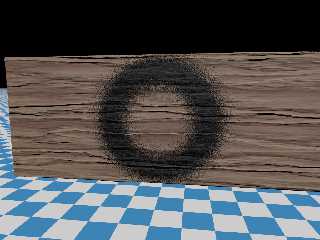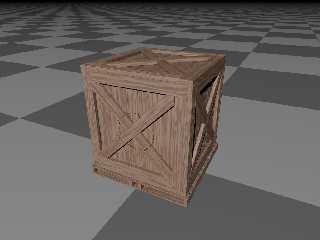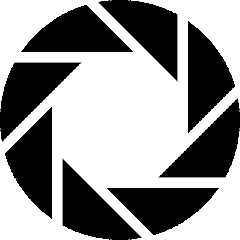 |
 |
|
 |
|
 |
|  |
|  |
|
 |
|
 |
|  |
|  |
|
 |
So... still working on my spraypaint macro... and it seems to be
progressing fairly well, but I'm having a slight problem that I just
can't seem to pin down.
The image below should illustrate, but to explain, with a random
distribution over an angle of about 30 degrees, my math tells me that
with the emitter at a distance of 1 unit (on a scale of 1 unit = 1 ft),
the paint swath should be six inches wide.
The problem is that it's clearly not that wide...
I'm perfectly willing to accept that the distribution is flawed in some
way (probably, a normal distribution doesn't accurately model the real
thing)
at any rate, I'm posting the code for a couple of test scenes with the
macro include and some pictures, I'd appreciate it if someone could give
me some clues here.
I've also attached the aperture science logo image I'm using as a stencil.
Also, I tend to use an extended color library kolors.inc which I haven't
attached, but it should be available if you google it. It's not really
necessary though.
Regards,
A.D.B.
Post a reply to this message
Attachments:
Download 'spraycan6.png' (591 KB)
Download 'utf-8' (3 KB)
Download 'crate2.png' (352 KB)
Download 'utf-8' (6 KB)
Download 'utf-8' (4 KB)
Download 'aperture_science_logo_800.jpg' (66 KB)
Preview of image 'spraycan6.png'

Preview of image 'crate2.png'

Preview of image 'aperture_science_logo_800.jpg'

|
 |
|  |
|  |
|
 |
|
 |
|  |
|  |
|
 |
ShadowMage3D <Sha### [at] spamnomore hotmail hotmail com> wrote:
> So... still working on my spraypaint macro... and it seems to be
> progressing fairly well, but I'm having a slight problem that I just
> can't seem to pin down.
>
> The image below should illustrate, but to explain, with a random
> distribution over an angle of about 30 degrees, my math tells me that
> with the emitter at a distance of 1 unit (on a scale of 1 unit = 1 ft),
> the paint swath should be six inches wide.
>
> The problem is that it's clearly not that wide...
>
> I'm perfectly willing to accept that the distribution is flawed in some
> way (probably, a normal distribution doesn't accurately model the real
> thing)
>
> at any rate, I'm posting the code for a couple of test scenes with the
> macro include and some pictures, I'd appreciate it if someone could give
> me some clues here.
>
> I've also attached the aperture science logo image I'm using as a stencil.
>
> Also, I tend to use an extended color library kolors.inc which I haven't
> attached, but it should be available if you google it. It's not really
> necessary though.
>
> Regards,
> A.D.B.
After a little more experimentation, I finally managed to get a credible result,
but it takes about 20 minutes to parse.
of course, I may be using heftier settings than necessary.
I increased the dispersal angle to 60 degrees, which didn't seem to have much
effect by itself. I also increased the particle count to 60k and the Duration
to 30. with a modified path based on a sine wave, I got the attached image.
all things considered, it's not a bad start, but I don't know if it will ever be
terribly practical, which is unfortunate.
I'll keep poking at it, and see if I can't make it faster.
Regards,
A.D.B. com> wrote:
> So... still working on my spraypaint macro... and it seems to be
> progressing fairly well, but I'm having a slight problem that I just
> can't seem to pin down.
>
> The image below should illustrate, but to explain, with a random
> distribution over an angle of about 30 degrees, my math tells me that
> with the emitter at a distance of 1 unit (on a scale of 1 unit = 1 ft),
> the paint swath should be six inches wide.
>
> The problem is that it's clearly not that wide...
>
> I'm perfectly willing to accept that the distribution is flawed in some
> way (probably, a normal distribution doesn't accurately model the real
> thing)
>
> at any rate, I'm posting the code for a couple of test scenes with the
> macro include and some pictures, I'd appreciate it if someone could give
> me some clues here.
>
> I've also attached the aperture science logo image I'm using as a stencil.
>
> Also, I tend to use an extended color library kolors.inc which I haven't
> attached, but it should be available if you google it. It's not really
> necessary though.
>
> Regards,
> A.D.B.
After a little more experimentation, I finally managed to get a credible result,
but it takes about 20 minutes to parse.
of course, I may be using heftier settings than necessary.
I increased the dispersal angle to 60 degrees, which didn't seem to have much
effect by itself. I also increased the particle count to 60k and the Duration
to 30. with a modified path based on a sine wave, I got the attached image.
all things considered, it's not a bad start, but I don't know if it will ever be
terribly practical, which is unfortunate.
I'll keep poking at it, and see if I can't make it faster.
Regards,
A.D.B.
Post a reply to this message
Attachments:
Download 'crate2.png' (360 KB)
Preview of image 'crate2.png'

|
 |
|  |
|  |
|
 |
|
 |
|  |
|  |
|
 |
On 21/10/12 10:08, Anthony D. Baye wrote:
> After a little more experimentation, I finally managed to get a
> credible result, but it takes about 20 minutes to parse.
>
> of course, I may be using heftier settings than necessary.
>
> I increased the dispersal angle to 60 degrees, which didn't seem to
> have much effect by itself. I also increased the particle count to
> 60k and the Duration to 30. with a modified path based on a sine
> wave, I got the attached image.
>
> all things considered, it's not a bad start, but I don't know if it
> will ever be terribly practical, which is unfortunate.
>
> I'll keep poking at it, and see if I can't make it faster.
Looking very good! It may have inconveniences, but this method also
has plenty of advantages... for example, an image map projection to the
whole object will give you paint in wrong places, like the sides of he
boards, but this spray-can method gives the Real Thing.
Hey, you could even become a virtual graffiti artist now!
--
Jaime
Post a reply to this message
|
 |
|  |
|  |
|
 |
|
 |
|  |
|  |
|
 |
On 21-10-2012 10:08, Anthony D. Baye wrote:
> all things considered, it's not a bad start, but I don't know if it will ever be
> terribly practical, which is unfortunate.
>
Like Jaime, I think this is an excellent method, worth the inconveniences.
Now a little nitpicking ;-) How about the /sides/ of the cross boards?
They do not seem to receive paint, which they should, maybe as streaks...
Thomas
Post a reply to this message
|
 |
|  |
|  |
|
 |
|
 |
|  |
|  |
|
 |
Thomas de Groot <tho### [at] degroot org> wrote:
> On 21-10-2012 10:08, Anthony D. Baye wrote:
> > all things considered, it's not a bad start, but I don't know if it will ever be
> > terribly practical, which is unfortunate.
> >
>
> Like Jaime, I think this is an excellent method, worth the inconveniences.
>
Thanks. I appreciate the complement.
> Now a little nitpicking ;-) How about the /sides/ of the cross boards?
> They do not seem to receive paint, which they should, maybe as streaks...
>
> Thomas
The sides of the boards do receive paint but, because the boards are iso's
rather than boxes, the sides are partially occluded. One could remedy this by
altering the target path slightly in strategic places. It may be automated, but
it doesn't remove the artistic element in the slightest.
Regards,
A.D.B. org> wrote:
> On 21-10-2012 10:08, Anthony D. Baye wrote:
> > all things considered, it's not a bad start, but I don't know if it will ever be
> > terribly practical, which is unfortunate.
> >
>
> Like Jaime, I think this is an excellent method, worth the inconveniences.
>
Thanks. I appreciate the complement.
> Now a little nitpicking ;-) How about the /sides/ of the cross boards?
> They do not seem to receive paint, which they should, maybe as streaks...
>
> Thomas
The sides of the boards do receive paint but, because the boards are iso's
rather than boxes, the sides are partially occluded. One could remedy this by
altering the target path slightly in strategic places. It may be automated, but
it doesn't remove the artistic element in the slightest.
Regards,
A.D.B.
Post a reply to this message
|
 |
|  |
|  |
|
 |
|
 |
|  |
|  |
|
 |
"Anthony D. Baye" <Sha### [at] spamnomore hotmail hotmail com> wrote:
> Thomas de Groot <tho### [at] degroot com> wrote:
> Thomas de Groot <tho### [at] degroot org> wrote:
> > On 21-10-2012 10:08, Anthony D. Baye wrote:
> > > all things considered, it's not a bad start, but I don't know if it will ever be
> > > terribly practical, which is unfortunate.
> > >
> >
> > Like Jaime, I think this is an excellent method, worth the inconveniences.
> >
> Thanks. I appreciate the complement.
>
> > Now a little nitpicking ;-) How about the /sides/ of the cross boards?
> > They do not seem to receive paint, which they should, maybe as streaks...
> >
> > Thomas
>
> The sides of the boards do receive paint but, because the boards are iso's
> rather than boxes, the sides are partially occluded. One could remedy this by
> altering the target path slightly in strategic places. It may be automated, but
> it doesn't remove the artistic element in the slightest.
>
> Regards,
> A.D.B.
Ok, so this should help ease the pain of long parsing times. I added the ability
to save the result in an include file (last parameter is a filename, no
extension)
To say that this drastically cuts parse times for subsequent renders using the
include file would be an understatement.
I also modified the macro call so that, if you don't want to use a stencil, all
you have to do is give it a solid black pigment (pigment { rgb 0 } works just
fine). this obviates the need for the Template_Type parameter, which has been
removed.
I'll upload the new version to p.b.u.
Regards,
A.D.B. org> wrote:
> > On 21-10-2012 10:08, Anthony D. Baye wrote:
> > > all things considered, it's not a bad start, but I don't know if it will ever be
> > > terribly practical, which is unfortunate.
> > >
> >
> > Like Jaime, I think this is an excellent method, worth the inconveniences.
> >
> Thanks. I appreciate the complement.
>
> > Now a little nitpicking ;-) How about the /sides/ of the cross boards?
> > They do not seem to receive paint, which they should, maybe as streaks...
> >
> > Thomas
>
> The sides of the boards do receive paint but, because the boards are iso's
> rather than boxes, the sides are partially occluded. One could remedy this by
> altering the target path slightly in strategic places. It may be automated, but
> it doesn't remove the artistic element in the slightest.
>
> Regards,
> A.D.B.
Ok, so this should help ease the pain of long parsing times. I added the ability
to save the result in an include file (last parameter is a filename, no
extension)
To say that this drastically cuts parse times for subsequent renders using the
include file would be an understatement.
I also modified the macro call so that, if you don't want to use a stencil, all
you have to do is give it a solid black pigment (pigment { rgb 0 } works just
fine). this obviates the need for the Template_Type parameter, which has been
removed.
I'll upload the new version to p.b.u.
Regards,
A.D.B.
Post a reply to this message
|
 |
|  |
|  |
|
 |
|
 |
|  |
|  |
|
 |
> On 21-10-2012 10:08, Anthony D. Baye wrote:
>> all things considered, it's not a bad start, but I don't know if it
>> will ever be
>> terribly practical, which is unfortunate.
>>
>
> Like Jaime, I think this is an excellent method, worth the inconveniences.
>
> Now a little nitpicking ;-) How about the /sides/ of the cross boards?
> They do not seem to receive paint, which they should, maybe as streaks...
>
> Thomas
>
>
In real life, it should be similar. Those edges are about parallel to
the path of the particles whitch preclude particles from touching them.
As for the particles path, using the sine? Sould'nt you use the tangent
of the angle instead? After all, the tangent is the function of the
projection of an angle on a line/plane tangent to the circle/sphere,
travel parallel to the line/plane in this case.
Alain
Post a reply to this message
|
 |
|  |
|  |
|
 |
|
 |
|  |
|  |
|
 |
Alain <kua### [at] videotron ca> wrote:
> > On 21-10-2012 10:08, Anthony D. Baye wrote:
> >> all things considered, it's not a bad start, but I don't know if it
> >> will ever be
> >> terribly practical, which is unfortunate.
> >>
> >
> > Like Jaime, I think this is an excellent method, worth the inconveniences.
> >
> > Now a little nitpicking ;-) How about the /sides/ of the cross boards?
> > They do not seem to receive paint, which they should, maybe as streaks...
> >
> > Thomas
> >
> >
> In real life, it should be similar. Those edges are about parallel to
> the path of the particles whitch preclude particles from touching them.
>
> As for the particles path, using the sine? Sould'nt you use the tangent
> of the angle instead? After all, the tangent is the function of the
> projection of an angle on a line/plane tangent to the circle/sphere,
> travel parallel to the line/plane in this case.
>
>
> Alain
the path I was talking about has nothing to do with the trajectory (well not by
itself) it is a spline which determines the path of the target point as the
emitter moves (also based on a spline).
so the spline resembles a sine wave with a high frequency, hence the emitter
travels up and down as it sprays particles, and the target point moves
similarly.
Regards,
A.D.B. ca> wrote:
> > On 21-10-2012 10:08, Anthony D. Baye wrote:
> >> all things considered, it's not a bad start, but I don't know if it
> >> will ever be
> >> terribly practical, which is unfortunate.
> >>
> >
> > Like Jaime, I think this is an excellent method, worth the inconveniences.
> >
> > Now a little nitpicking ;-) How about the /sides/ of the cross boards?
> > They do not seem to receive paint, which they should, maybe as streaks...
> >
> > Thomas
> >
> >
> In real life, it should be similar. Those edges are about parallel to
> the path of the particles whitch preclude particles from touching them.
>
> As for the particles path, using the sine? Sould'nt you use the tangent
> of the angle instead? After all, the tangent is the function of the
> projection of an angle on a line/plane tangent to the circle/sphere,
> travel parallel to the line/plane in this case.
>
>
> Alain
the path I was talking about has nothing to do with the trajectory (well not by
itself) it is a spline which determines the path of the target point as the
emitter moves (also based on a spline).
so the spline resembles a sine wave with a high frequency, hence the emitter
travels up and down as it sprays particles, and the target point moves
similarly.
Regards,
A.D.B.
Post a reply to this message
|
 |
|  |
|  |
|
 |
|
 |
|  |
|  |
|
 |
On 21-10-2012 23:18, Alain wrote:
>> Now a little nitpicking ;-) How about the /sides/ of the cross boards?
>> They do not seem to receive paint, which they should, maybe as streaks...
>>
>> Thomas
>>
>>
> In real life, it should be similar. Those edges are about parallel to
> the path of the particles whitch preclude particles from touching them.
Yeah, but in real life the painter would never hold the spay can at
exactly 90 degrees the whole time, and I suppose the spray would show
some random perturbations too... not even talking about a sudden gust of
wind ;-)
Thomas
Post a reply to this message
|
 |
|  |
|  |
|
 |
|
 |
|  |
|
 |




![]()